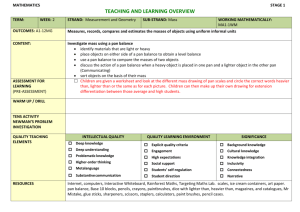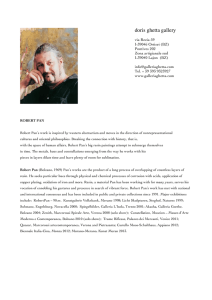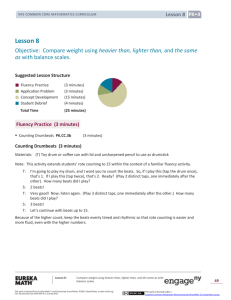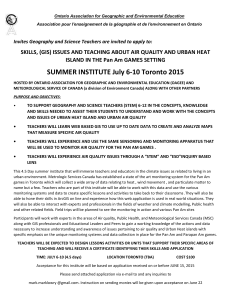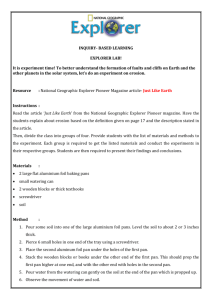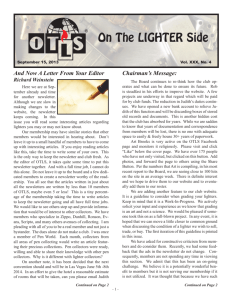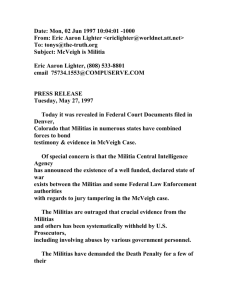MASS - Stage 1 - Plan 3 - Glenmore Park Learning Alliance
advertisement
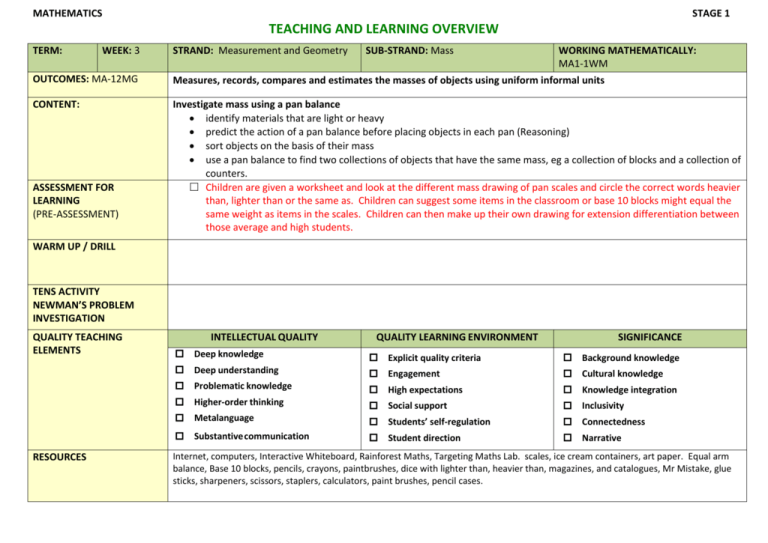
MATHEMATICS STAGE 1 TEACHING AND LEARNING OVERVIEW TERM: WEEK: 3 OUTCOMES: MA-12MG CONTENT: ASSESSMENT FOR LEARNING (PRE-ASSESSMENT) STRAND: Measurement and Geometry SUB-STRAND: Mass WORKING MATHEMATICALLY: MA1-1WM Measures, records, compares and estimates the masses of objects using uniform informal units Investigate mass using a pan balance identify materials that are light or heavy predict the action of a pan balance before placing objects in each pan (Reasoning) sort objects on the basis of their mass use a pan balance to find two collections of objects that have the same mass, eg a collection of blocks and a collection of counters. Children are given a worksheet and look at the different mass drawing of pan scales and circle the correct words heavier than, lighter than or the same as. Children can suggest some items in the classroom or base 10 blocks might equal the same weight as items in the scales. Children can then make up their own drawing for extension differentiation between those average and high students. WARM UP / DRILL TENS ACTIVITY NEWMAN’S PROBLEM INVESTIGATION QUALITY TEACHING ELEMENTS RESOURCES INTELLECTUAL QUALITY QUALITY LEARNING ENVIRONMENT SIGNIFICANCE Deep knowledge Explicit quality criteria Background knowledge Deep understanding Engagement Cultural knowledge Problematic knowledge High expectations Knowledge integration Higher-order thinking Social support Inclusivity Metalanguage Students’ self-regulation Connectedness Substantive communication Student direction Narrative Internet, computers, Interactive Whiteboard, Rainforest Maths, Targeting Maths Lab. scales, ice cream containers, art paper. Equal arm balance, Base 10 blocks, pencils, crayons, paintbrushes, dice with lighter than, heavier than, magazines, and catalogues, Mr Mistake, glue sticks, sharpeners, scissors, staplers, calculators, paint brushes, pencil cases. TEACHING AND LEARNING EXPERIENCES WHOLE CLASS INSTRUCTION MODELLED ACTIVITIES Lesson: Compare and Measure Mass Show the flashcards heavier, lighter and the same and children identify with them. Put an item from the classroom eg a stapler into one side of the pan balance/scales. Put another item for example a book into the other side. GUIDED & INDEPENDENT ACTIVITIES LEARNING SEQUENCE Remediation ES1 LEARNING SEQUENCE S1 Children label each side of the balance with the flashcards. Repeat with other items. Children place 20 counters in one of the pans. A child suggests what item in the classroom would be heavier than the counters. Try the suggestion and repeat. A child suggests what item in the classroom would be lighter/the same as the counters. Try the suggestion and repeat. Using a pan balance. Children place a large object on one side of the pan balance and use lighter objects to balance the pan balance. Children draw their observations and count how many lighter objects were needed to balance both sides of the pan balance. LEARNING SEQUENCE Extension Early S2 EVALUATION & REFLECTION Lesson/Activity Lighter/heavier than. Play in pairs. Each pair needs a die with lighter or heavier than written on it, an equal arm balance and twenty unifix cubes each. Both put some unifix cubes into one side of the balance. If the pans balance the game starts again. If they are different one child throws the dice. If the dice shows lighter than, the child with the lighter side takes all the unifix cubes and vice versa. The game continues until one child has all the pieces. Equal Masses: Choose an object. Students collect things from around the room that might combine to have the same mass as an object, eg. The duster has the same mass as three pencils and four rubbers. Repeat activity many times, measuring the mass of different objects Did the students enjoy the activity? Were the outcomes achieved? Where to next? Language Mass, heavy, light, hefting, heavier, equal, lighter, equal arm balance, scales All assessment tasks should be written in red and planning should be based around developing the skills to complete that task. Assessment rubrics or marking scale should be considered.
